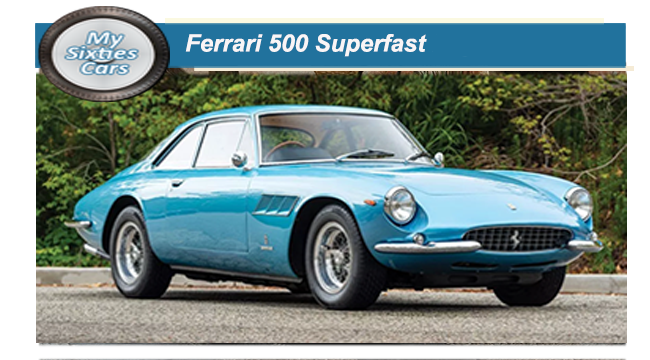
While their gradual transition to producing models that would appeal to a broader market was going well, Ferrari still felt the need to have at least one model in their range that would serve as their flagship.
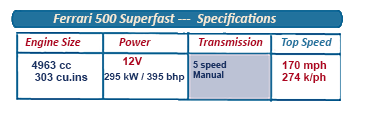 The policy was that the flagship model could only be within the financial reach of the very few privileged people for whom the price tag was a minor consideration when compared with the levels of exclusivity, luxury and performance that the model provided.
The policy was that the flagship model could only be within the financial reach of the very few privileged people for whom the price tag was a minor consideration when compared with the levels of exclusivity, luxury and performance that the model provided.
This was certainly the case with the Ferrari 400 Superamerica, which had been available since 1960, as a platform for the rich and famous for their custom design and unique performance cars.
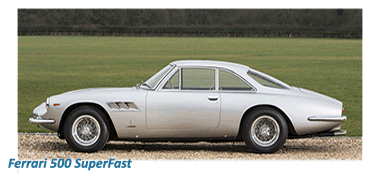 When the 400 SuperAmerica began to look jaded, Ferrari were already in place with its successor, the Ferrari 500 Superfast with the wraps coming off in and around Geneva Salon in March of 1964.
When the 400 SuperAmerica began to look jaded, Ferrari were already in place with its successor, the Ferrari 500 Superfast with the wraps coming off in and around Geneva Salon in March of 1964.
Power for the 500 Superfast came from a specially developed 4962cc (303 cu in) engine, jointly developed on behalf of Ferrari by two of the most talented engineers of the era, Gioacchino Colombo and Aurelio Lampredi.
Colombo and Lampredi, who had previously worked with Ferrari on several projects, surpassed themselves with the 500 Superfast, developing an engine capable of generating 400bhp, capable of reaching speeds of more than 274km/h (170mph) including 161km/h (100mph) in second gear.
![]()
Of the 36 “Superfasts” produced, around half came fitted with an all-synchromesh five-speed gearbox, another first for Ferrari.
To Ferrari followers, the 500 Superfast’s `Aerodinamico' ancestry was apparent although with cleaner and less cluttered lines than first seen on the Ferrari 400 range.
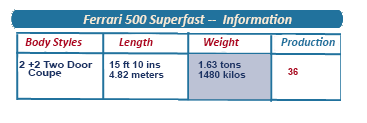 The 500 Superfast stood out, thanks to its uniquely designed rear end, dominated by an outstandingly long overhang taking in a semi-fastback trunk and rear “Kamm” tail.
The 500 Superfast stood out, thanks to its uniquely designed rear end, dominated by an outstandingly long overhang taking in a semi-fastback trunk and rear “Kamm” tail.
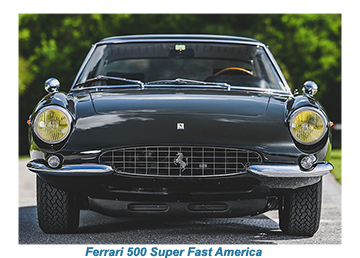 The 500 front was also an exercise in style, combining an oval grill, protruding fenders and twin bumpers, a design feature which became a standard on all later Ferrari models.
The 500 front was also an exercise in style, combining an oval grill, protruding fenders and twin bumpers, a design feature which became a standard on all later Ferrari models.
Just 37 versions of the 500 Superfast were produced, yet another indication that Ferrari’s attempt to break into the North American market was still not bearing fruit.
![]()
Ferrari had offered lots of luxury options and features fit for wealthy, high-profile customers among them English film star Peter Sellers, known follower of anything luxurious and exclusive.
Other lower-profile owners included Prince Bernard of the Netherlands, Shah Reza Pahlevi of Iran and Prince Sadruddin Aga Khan.
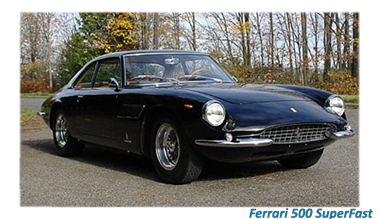 Despite its impressive list of owners, the 500 Superfast was the last of the limited-production closed Ferraris.
Despite its impressive list of owners, the 500 Superfast was the last of the limited-production closed Ferraris.
It had taken him a lot of years and cost him many millions, but Enzo Ferrari had finally grasped the concept that it was ultimately more profitable for his company to produce more vehicles with a lower price tag.







